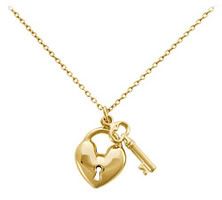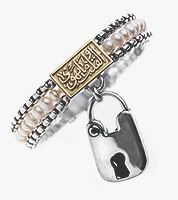 |  |
Right: From Azza Fahmy's Valentine collection of a padlock bracelet
The Kennedy Center in Washington D.C. just wrapped up a giant festival of three weeks called Arabesque: Art of the Arab World. The festival took five years to prepare, and involved twenty two Arab countries. According to a Washington Post article, the festival was meant to:
[Unshackle] ourselves from blurry stereotypes and half-formed conceits, [where] we will step into their world without leaving the borders of our city.One exhibition that caught my attention is the work of Egyptian jeweler Azza Fahmy. She has many categories for her designs, including one called Rumuz which means symbols, and which is really a collection of the ancient Middle Eastern or Islamic symbols that she incorrectly (or deliberately?) tries to pass off as universal.
But, more interesting is her Valentine's collection. There is not a single heart (for love) in her designs. Instead, they are full of keys and padlocks. Many Valentine's designs for keys and locks almost always depict the lock in the shape of a heart, but Fahmy doesn't do this even once.
I understand that she trying to give a visual reference to the cliché "the key to my heart", given the title of her collection. But her designs seem to be referring to "the prisoner of my desires" instead.
I always think that at a fundamental level artists (and designers) cannot lie, and if they are forced to, they dry up and can no longer produce their works. I think it is the same with Fahmy. Since she cannot incorporate the heart (for love) into her works, she has to forfeit the heart shape for a generic padlock in order to continue with her Valentine's theme.
This of course brings on more sinister meanings of Arab (or more precisely Muslim) women shackled (to use a word in the program notes) in the homes and lives of their men. These women are locked behind the hijab as they are prisoners in their homes and victims of their husbands' beatings. The Koran says:
Men shall take full care of women with the bounties which God has bestowed more abundantly on the former than on the latter, and with what they may spend out of their possessions. And the righteous women are the truly devout ones, who guard the intimacy which God has [ordained to be] guarded. And as for those women whose ill-will you have reason to fear, admonish them [first]; then leave them alone in bed; then beat them… (4:34)There is a tenderness to the first part of this Koranic verse, but as it progresses, and as it describes the potential rebellion of a wife, it gets more violent to the point of allowing the husband to beat his disobedient wife.
Fahmy has said that she likes to put Koranic verses in her jewelry. She is obviously "consciously" mesmerized by the more poetic and gentle verses. But her art exposes the more violent ones, in this case showing us the jailer rather than the lover. This is the fate of artists. They are forced, in one way or another, to reveal the truth.
